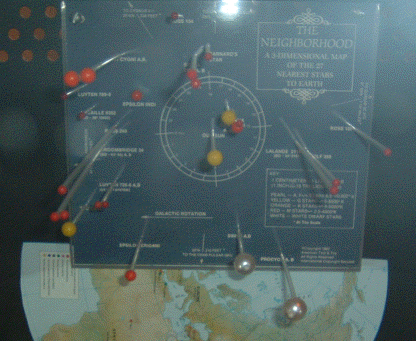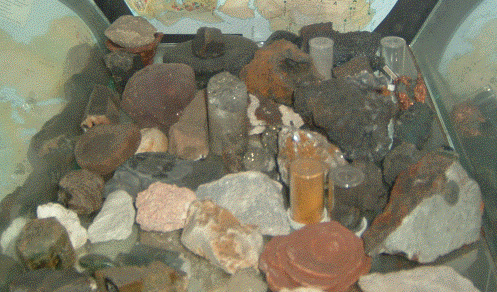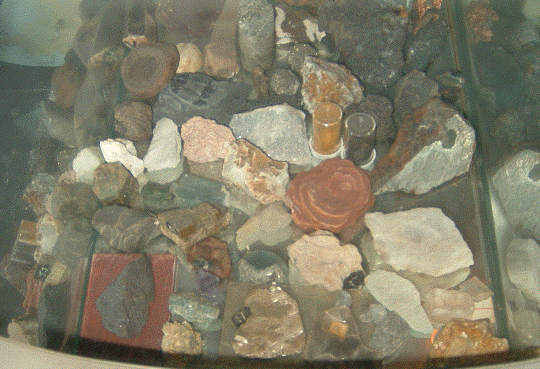Tony Smith's Home Page
My father, Frank Dodd Smith, was
a miner. Inside the first TV set our
family had (in the 1950s) is now a star map and mineral collection.



Many of minerals were given to me by a Clemson geologist friend of
my father. My father gave me some of them himself. The following
material on this web page is an edited version of some comments made
by my father in January 1983, only a little more than 3 years before
he died in 1986.
Frank Dodd Smith - comments on the
History of Mining in Bartow
County, Georgia, U.S.A.
This presentation of my knowledge of the history of the mining
industry of Bartow County is made with the understanding that no
changes will be made without my approval.
The history of the Bartow
County mining industry would not exist without the efforts of the
Mine Workers who worked long hours for little pay.
Some of the minerals in Bartow County
are:
IRON ORE,
LIMONITE AND HEMATITE
The production of these minerals started about 1800. First, it
furnished the several charcoal furnaces that operated in Bartow
County. In the early 1800's, several families moved from Sweden to
Emerson, Bartow County, Georgia, to build a plant to produce gray
iron (castings), using high grade pig iron from charcoal furnaces.
After disagreements with the govenrment of Emerson, Georgia, they
moved their operation to Ironton, Ohio, where it is now a major
industry.
Mr. Mark A. Cooper built a
furance and rolling mill on the Etowah River and was operating
successfully at the start of the Civil War. General
Sherman of the Union Army destroyed Cooper Iron Works on his way
to Atlanta.
About 1900, there were large iron ore deposits opened throughout
the district. Railroads were built from the main railroad lines to
the iron deposits. The major producers were:
- Joel Hurt
- Sims Monford
- Barney Sloan
- William S. Peebles
The output was used by furnaces in Tennessee and Alabama.
In 1939, Fred Knight, Sr ., and Frank Smith built the first iron
ore washer in Georgia to be built after the Great Depression.
Later, John W. Hodge built a washer and became one of the biggest
shippers in the South.
Other miners of iron ore were:
- Toy Harris
- W. S. Knight
- George Shropshire
- Joe Mosteller
- J. R. McCoy
- B. R. Cain
BARYTES
Barytes was first mined in the 1800's, near Allatoona, a town in
the southeast part of Bartow County. Dornicks were hand mined. The
outside dirt was chipped off and the clean ore was put in bags and
shipped to Germany to make barium chemicals. At the outbreak of World
War I, barium chemicals from Germany became unavailable, so the
American chemical companies were forced to find sources of barite and
to build plants. Barite deposits were found in Virginia, Missouri,
Tennessee and Georgia. The quality of the Georgia barytes attracted
miners from various states.
Among them were:
- Nulson and Torbert, who started Paga Mines
- Harris Cope started Parrot Springs
- W. J. Weinman and Barney Sloan built a washer and started
Section House
- New Jersey Zinc started Bertha Minerals Company
- DuPont operated as DuPont
- Nulson, Kline and Krouse operated as NKK
- W. C. Satterfield started New Riverside Ochre Company
- L. A. Woods started Barytes Mining Company
- B. R. Cain operated as Cain Mining Company
- Frank Smith operated Georgia Barium and Ochre Company
- T. E. Johnsey operated as T. E. Johnsey
- L. J. Scott
- George Shropshire
- Joe Mosteller
- Toy Harris
W. J. Weinman, Bill Peebles and Evans, grandfather of Marshall
Evans, purchased Paga Mines & Company, which has been the largest
producer of barite in Bartow County, and, along with New Riverside
Ochre Company, are now the only producers.
In the 1930's, W. J. Weinman, E. P. Earle, J. M, Neel, and Ray
Dellinger, son-in-law of Will Satterfield, the operator of New
Riverside Ochre Company, started Chemical Products Company to make
barium chemicals. Later, Weinman and Earle sold their interest in
Chemical Products Corporation to Neel, Dellinger, and Fred Lester;
later this company was purchased by J. R. Dellinger and J. R.
Dellinger, Jr. Upon retirement of J. R. Dellinger, Jim Dellinger
became owner and operator of Chemical Products and New Riverside
Ochre Company. Chemical Products is under the acting supervision of
J. L. Gray, President and Chemist. This is one of the largest
employers in Bartow County. Paga Mines, under the supervision of W.
J. Weinman, ground barytes for the filler, chemical, and oil well
drilling industries. In the 1920's, W. J. Weinman, Evans and Thompson
purchased an old flour mill with water power and formed
Thompson-Weinman Company. Thompson was a mineral broker in New York
City, Evans was in the mineral business in Charleston, West Virginia.
Weinman's father had had a plant in Virginia bleaching Virginia
barytes, so Thompson-Weinman installed equipment in the old flour
mill to do the same to Georgia Barytes. They hired a Mr. Quasebarth
to operate the plant. They could not bleach Georgia barytes. One day
Mr. Weinman was in Birmingham, Alabama, and saw a pile of white rock
at a furnace. He stopped and asked what the rock was. It was scrap
marble from the quarries at Sylacauga, Alahama. He purchased a
carload and ground it on the mill that he had installed to grind
bleached baryte. This was the beginning of the calcium carbonate
industry in the Ur.ited States, which is now one of the major
non-metallic industries in the U. S. The original ball mill was now
on display at the Thompson-Weinman plant near Cartersville. Weinman's
daughter, Frances Luro, had a home in Cartersville, where her husband
trained race horses. One of the horses trained was Northern Dancer.
Thompson-Weinman Company iswas acquired by Amoco Mineral Division of
Standard Oil Company of Indiana.
OCHRE
Mr. E.P. Earle, a mineral broker of New York City, was on the
train to Florida when he saw yellow iron oxide in the banks of the
railroad cut. He had been importing ochre from Peru for the use of
making heavy lineoleum. He found that Georgia ochre was superior to
the Peruvian ochre, so he built a plant at Emerson, Georgia, and
named it Georgia Peruvian Ochre Company. He acquired other mineral
properties in the district, which he leased to other mines. Mr. Earle
later purchased the Nipissing Mining Company, in Canada, and with
five associates, built the Empire
State Building in New York City. Following the start of the
Georgia Peruvian Ochre Company, these ochre mines and plants were
built:
- American Ochre Company by Vick Waits
- Cherokee Ochre Company by John Akin
- Blue Ridge Ochre Company by Harris Cope
- New Riverside Ochre Company by Will Satterfield and Associates
(this ochre company was started about 1914 and is the only ochre
producer in the U. S. today, and is under the supervision of Jim
Dellinger, grandson of the founder W. C. Satterfield)
- Holden Brothers
- Frank Smith
- Lee Womeledorf, who was engineer with Georgia-Peuvian Ochre
Company
- Bertha Minerals Company
UMBER
Large tonnages of this iron, with manganese, was shipped to the
steel industry, mainly to supply manganese, which is essential to
making steel. Most of this large tonnage was made during wartime,
when the imports of manganese stopped. Umber is also used to color
concrete, paint, etc., and is produced by the New Riverside Ochre
Company, in addition to their ochre and barytes.
LIMESTONE
There are large deposits of both types of limestone, high calcium
and dolomite. The calcium limestone is used to make cement and
aggregate. In the 1800's, the Howard Cement Company produced high
quality cement and, about 1960, Marquette Cement Company produced
cement and, later, Martin-Marietta opened quarries to furnish their
plant in Atlanta, Georgia. There have been several quarries opened to
produce crushed aggregate.
In the 1800's, a large deposit was opened and plant built to make
high magnesium lime. It was named Ladd Lime & Stone Company. Mr.
Henry Harvey, with Mr. Wilson Hardy, of Rome, and Billy Jackson, of
Cartersville, bought the enterprise, which was for years the largest
employer in the mining industry in Bartow County. The lime produced
was ideal for making baking powder and many other chemicals
In the early 1900's, the Hoagland family, owners of Rumford Baking
Powder Company, of New Jersey, purchased this plant to insure a
source of this type of lime. They sent a Mr. L. J. Backus, of New
York, to operate this plant. Mr. Harvey's family contributed to the
community (his daughter Ann married Dr. Sam Howell, whose son Harvey
and grandson Sammy are prominent doctors in Bartow County).
MANGANESE
This mineral has contributed much to Bartow County by attracting
many new citizens. The mineral is essential in making steel and
chemicals but, after supplying the needs during wartime, the ore was
imported from foreign countries.
Mr. A. O. Granger came from Pennsylvania in the 1800's, after
mining in South America. His family contributed a great deal to the
cultural development of this community and to Atlanta. They built the
largest telescope observatory south of the Ohio River. Others who
mined manganese were:
- Joel Hurt
- A P. Silva
- W. S. Knight
- T. E. Johnsey
- Holmes Neel
- John W. Hendry
- Bob Hale
- Frank Smith
- Sub Mosteller (a blind man who successfully mined manganese on
property rejected by the geologists of all the major steel
companies)
BAUXITE
The first aluminum made in the U. S. was mined in Bartow and Floyd
counties by the present Aluminum Company of America. A local man, Mr.
Gibbons, operated these mines and also deposits in Arkansas, where
the town near the deposits was named for him. He became a top
official of Alcoa. The American Cyanamid Company mined bauxite to
make alum. Large foreign deposits caused local mining to cease.
[ According to Geological Survey of Georgia Bulletin No. 11, A
Preliminary Report on the Bauxite Deposits of Georgia, by Thomas L.
Watson (1904), "... Bauxite was first discovered in 1821, by the
famous chemist, Berthier, at the Village of Baux, Bouches du Rhone,
in Southern France, from which locality the mineral takes its name.
... The first discovery of bauxite in America was in 1887, at a point
a few miles northeast of Rome, in Floyd county, Georgia. A few
fragments of the unknown mineral were picked up on the Holland lot,
two miles north of the Ridge Valley Iron Company's furnace at
Hermitage. ... The bauxite fragments were highly ferruginous and
deep-red in color, and were taken by their discoverer, James Holland,
to Edward Nichols, President and Acting Chemist of the Ridge Valley
Iron Company, thinking they represented an ore of iron. Mr. Nichols
attached no special importance to the find at that time; but, shortly
afterwards, he made a chemical analysis of the fragments. ... Mr.
Nichols identified the material as the mineral, bauxite. He briefly
described the discovery and occurrence of the mineral in the
Transacations of the American Institute of Mining Engineers for 1887.
[vol. XVI p. 105] Bauxite mining in the United States had its
beginning in Georgia, when, in April, 1888, the deposits of the
mineral on the Holland property, lot 61, 23rd district of Floyd
county, were first opened and worked. The first shipments of the ore
were made in May, 18889, to the Pennsylvania Salt Company at Natrona,
Penn., and to Greenwich Point, near Philadephia. This lot of ore is
said to have been used for the manufacture of both alum and metallic
aluminum. In 1889, 728 tons of the ore from Georgia included the
total output of bauxite from the United States. ... [The 728 tons
were long tons of 2,240 pounds per ton, and the total value of the
728 tons mined in 1889 ws $2,366.] ... In number of deposits
[of bauxite], the Hermitage district is the largest in the
State [of Georgia]. It includes an area of more than 50
square miles, lying between Rome, Kingston and Adairsville, east of
the Oostanaula rive, and north of the Etowah river. It further
occupies the contiguous northeastern and northwestern portions,
respectively, of Floyd and Bartow counties. ..."]
TRIPOLI
In 1923, Father O'Hara, a Catholic priest
and geologist, came here looking for all minerals. Among the
deposits he found was a deposit of tripoli in the western part of
Bartow County. This is a high grade material, but the deposits in
Oklahoma and Missouri have been able to furnish this mineral to the
abrasive and polishing industry.
POTASH SLATE AND SHALE
Before the start of World War I, all potash used in the U. S. was
imported from Germany. Because of the high potash content of the
local slate and shale, a plant was built by American Potash Company
in Marietta, Georgia, to produce potash. They had started shipping
when large and high grade potash deposits were found near Carlsbad,
New Mexico, making the venture in Georgia unprofitable. There are
huge reserves of potash shale remaining in Bartow County and should
be profitable deposits, if the expense of foreign ore becomes too
high. The slate has been a major industry in making roofing granules.
It was operated for years by the Funkhauser Company and recently by
Rubberoid and GAF,
BRICK CLAY
These have contributed materially to make brick, roofing tile, and
floor tile. Many of the buildings now standing in Bartow County were
made with brick made from these shales and clays. One ceramic tile
company, the Universal Ceramic Company, is now making a very high
grade tile at Adairsville, Georgia, in north Bartow County.
GOLD
Gold was found and mined in Bartow County before the Civil
War.
An English company purchased and mined the Glade property.
A Mr. Tudor of Boston mined at Allatoona after he had become
wealthy by hauling ice from New England to Carribbean Islands. The
last gold was shipped by Tudor's grandson in the 1930's to a New
Jersey smelter, where he received $35.00 per ton for it. This was
before the price of gold shot up. This shaft was inundated by
Allatoona Lake.
GRANITE
Large deposits of high quality granite have been drilled and
should furnish the Atlanta area after the deposits closer to Atlanta
have become inaccessible.
COBALT
This mineral has been found associated with manganese and iron ore
in Bartow County. Since there was no analysis made of cobalt in the
large tonnages of iron ore and manganese shipped over the past 100
years, the possibility of commercial tonnage of this essential
mineral is favorable because of the remaining large tonnages of iron
and manganese.
TITANIUM
This important mineral has recently been found in the Cartersville
mineral district in commercial quantities by Georgia Tech
Researchers. As this mineral is so important to U. S. industry and
defense, it is possible that this ore will eventually be mined.
SULFIDES
Recent geological surveys indicate that below the zone of
weathering throughout the Cartersville Mineral District, which is
some 20 miles long and 4 miles wide, there are commercial deposits of
sulfide which contain the following minerals, plus possibly
others:
- iron
- copper
- silver
- lead,
- arsenic
- gold
- nickel
- zinc
There has never been a drill hole to the unweathered zone. All the
minerals mined here in the past 100 years have been mined in the
weathered zone.
SILICA AND QUARTZ
These minerals have been produced throughout the years to supply
the construction industry. Building stone from Pine Log Mountain has
been sold throughout the South.
HALLOYSITE
Halloysite, a rare type of kaolin, has been found in the mining of
iron ore and manganese. It is used to make catalysts. It is mined at
one location, in Eureka, Utah.
PICROLITE
Large tonnages of this serpentine type mineral were found by W. J.
Weinman and Frank Smith, but the deposit is now covered by Allatoona
Lake.
BLACK LEAD OR GRAPHITE
The mining of this mineral was started by an English firm. They
sold most of it as a fertilizer filler because of its color. They
also made a vitrified brick. Both of these uses became obsolete.
OTHER MINERALS
Other Bartow County minerals known to have economic possibilities
are:
- saltpeter
- serpentine
- mica
- sericite
Tony Smith's Home Page
......


